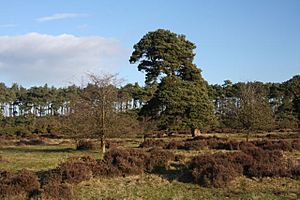Berner's Heath facts for kids
| Site of Special Scientific Interest | |
 |
|
| Area of Search | Suffolk |
|---|---|
| Interest | Biological |
| Area | 236.9 hectares |
| Notification | 1983 |
| Location map | Magic Map |
Berner's Heath is a large natural area in Suffolk, England. It covers about 237 hectares, which is like 585 football fields! This special place is protected because of its amazing wildlife. It's known as a Site of Special Scientific Interest (SSSI). It's also recognized as a Special Area of Conservation and a Special Protection Area, showing how important it is for nature.
About Berner's Heath
Berner's Heath is located north-east of Icklingham in Suffolk. It was officially recognized as a Site of Special Scientific Interest in 1983. This means it's a very important place for plants, animals, and natural features.
A Home for Wildlife
Berner's Heath is the biggest area of heather-covered land left in a region called the Brecks. The heather here is managed carefully. Parts of the heath are burned in rotation. This helps create areas of heather of different ages.
- Younger heather areas have small plants like sheep's sorrel and mosses.
- Older heather areas have more types of plants. These include heath bedstraw and lady's bedstraw.
- These older areas also support many different kinds of insects.
At the edges of the heath, especially in the south, you can find grassy areas. These grasslands mix with the heather. They are mostly covered by a grass called sheep's fescue. There are also some areas with chalky soil. You can also see Scots pine trees growing along the southern edge.
A Look Back in Time
Before it became a protected nature site, Berner's Heath had a different use. From 1936 until after World War II, it was used as a high-altitude bombing range. This means it was a place where planes practiced dropping bombs from high up.
Visiting Berner's Heath
Berner's Heath is open to the public. You can usually visit between November and February. This specific visiting time is important. It helps make sure that ground-nesting birds are not disturbed. These birds need peace and quiet during their nesting season.

